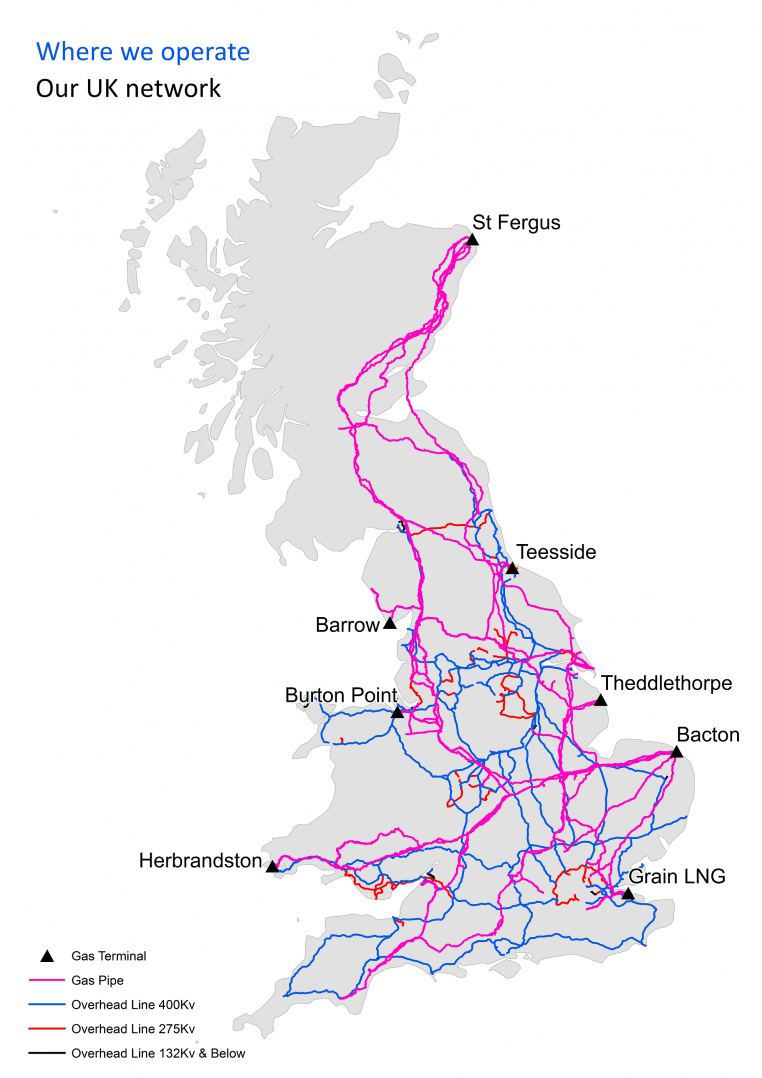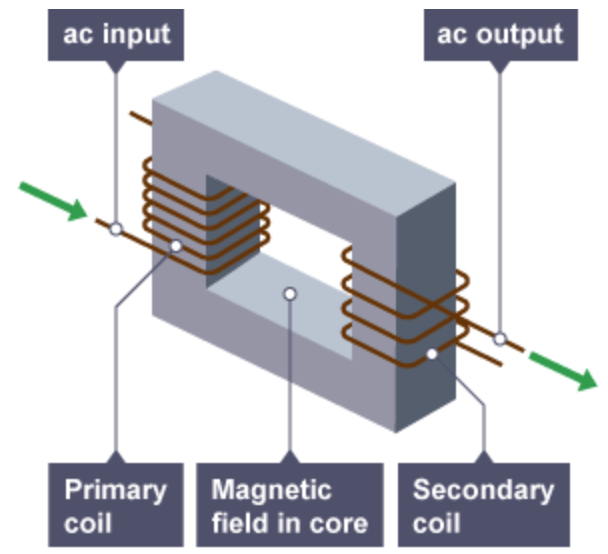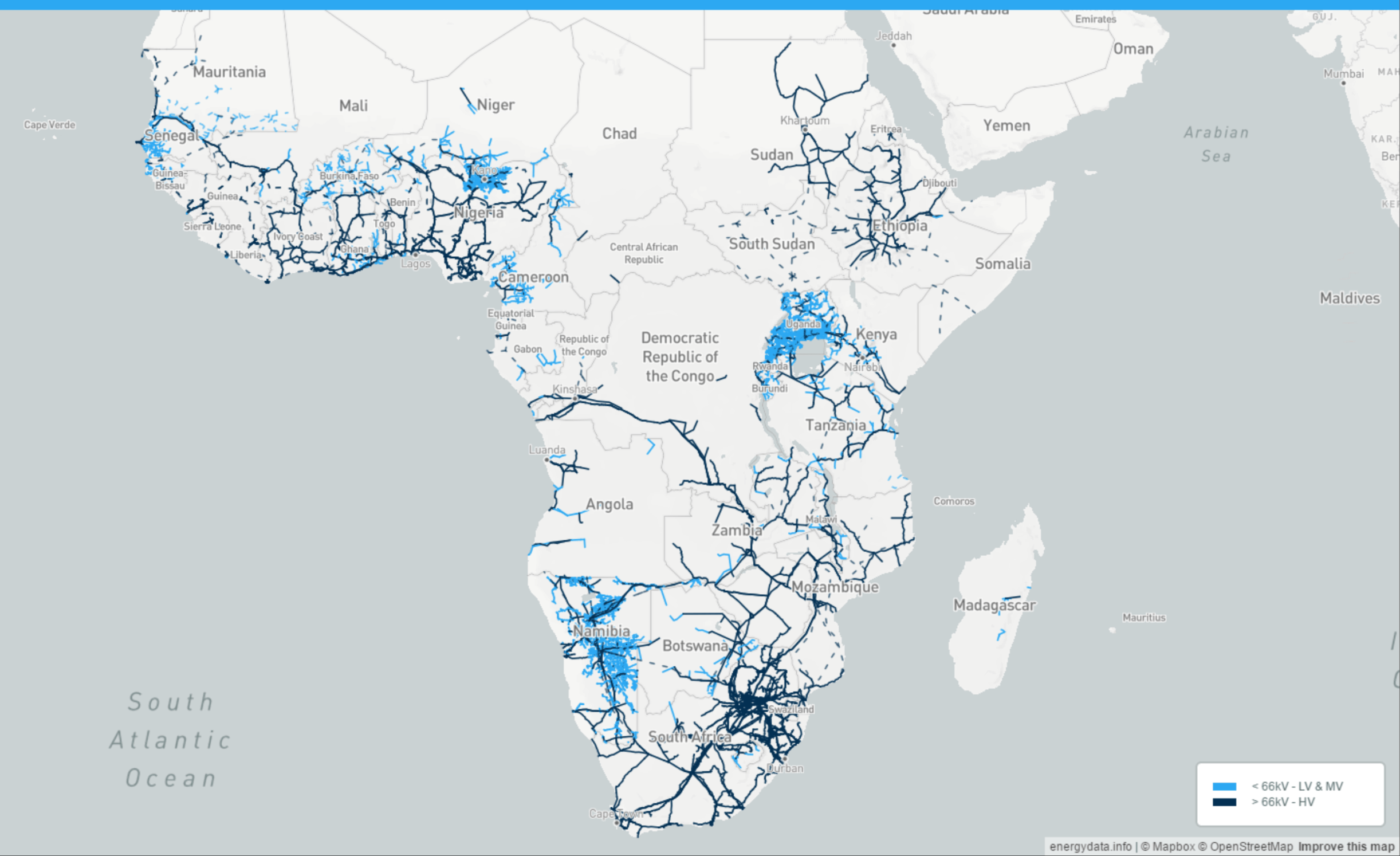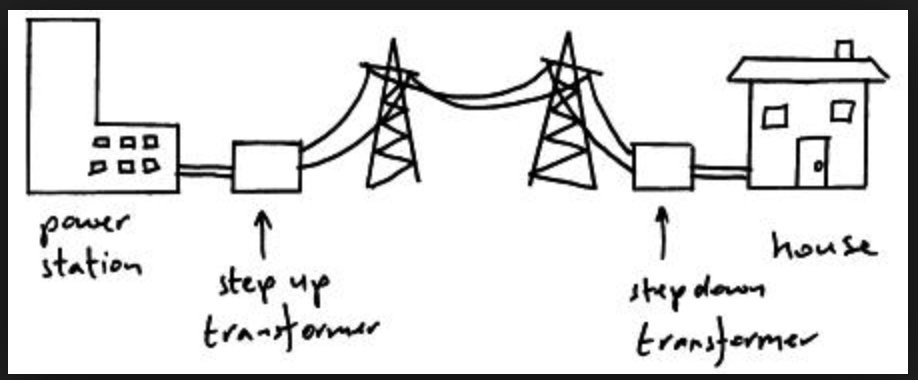Objectives
- To understand that the National Grid is a system of cables and transformers linking power stations to consumers, transferring electrical power to them.
- To understand that step-up transformers are used to increase the p.d. from the power station to the transmission cables then step-down transformers are used to decrease, to a much lower value, the p.d. for domestic use.
- You will also need to appreciate why transformers are used in this way, linking it to current, resistance and energy losses.
What is the National Grid?
You will no doubt have seen the National Grid when driving along a motorway across the country within the UK. It consists of big pylons and cables which hang from and between each, alternatively some cables can be buried underground.
 The National Grid is a large system which all power stations in England, Wales and Cornwall are connected to. This system of cables provide each house, school, office etc. a supply of electricity (providing the power stations are working). Since, in England, Wales and Scotland, all power stations are connected to the National Grid, if one power station fails then all of the others can just work a bit harder to meet the demand required from the consumers.
The National Grid is a large system which all power stations in England, Wales and Cornwall are connected to. This system of cables provide each house, school, office etc. a supply of electricity (providing the power stations are working). Since, in England, Wales and Scotland, all power stations are connected to the National Grid, if one power station fails then all of the others can just work a bit harder to meet the demand required from the consumers.
Some countries have setup similar systems but connect a set of cables and pylons to only one power station – if that one power station fails then all of the homes connected to it will lose their electrical energy supply.
 The above image shows some of the UK’s power stations with the connecting National Grid system. Below shows areas of Africa (of which are joined together, but if you look closely at places like Angola for example, the lines are singular and therefore may not connect to more than 1 power station. If that power station were to fail that whole region would lose access to electricity.
The above image shows some of the UK’s power stations with the connecting National Grid system. Below shows areas of Africa (of which are joined together, but if you look closely at places like Angola for example, the lines are singular and therefore may not connect to more than 1 power station. If that power station were to fail that whole region would lose access to electricity.
Think about the bad weather we have had in recent years… it could take significant time for a power station to get back up into working order – how long could you manage without electricity?
Difficulties with transmitting electricity
What do you imagine are the major difficulties that need to be overcome when transmitting electricity over long distances?
- Lots of resources are required: The National grid costs a huge amount of money to install and maintain. Those cables you see hanging beside motorways are very heavy and contain a lot of metal in them!
- Resistance and energy loss: As we have already learned on Resistance and Ohm’s Law, the longer a wire is, the more atoms there are and therefore the more resistance there ends up being. The more resistance, the more ‘collisions’ between electrons and nuclei there and the more energy is lost in the form of heat.
There are two solutions, the first being to put lots of cables all around the country in parallel to one another, this then lowers the resistance and as a result lowers energy loss. But, this will double, triple perhaps quadruple the amount of resources required – not an efficient method.
The second method is to use transformers.
One purpose of a transformer in the National Grid is to reduce the resistance thereby reducing wasted energy.
A transformer transforms the electricity into a different ratio of voltage and current. As a result there are two types:
Step-up Transformer: These step-up the voltage which in turn, decreases the current. If there is less current flowing, there are fewer electrons per unit time, less collision, less resistance and ultimately less wasted energy.
Step-down Transformer: These do the reverse, they step down the voltage, which increases the current. This is usually done so that the current is sufficient for the users needs.
This does of course lead to an increase in resistance and a loss of energy. The step-down transformers will usually be placed somewhere near to the consumer (i.e. homes, schools etc.), therefore the distance the higher current travels is not too far to worry about significant energy loss.
The generation and transmission of electricity
As you know, electricity is primarily generated in power stations. These power stations then send electricity through a step-up transformer and on to the national grid. At the other end of the national grid (where us consumers are), there is a step-down transformer lowering the voltage and increasing the current to suit our needs.
Sometimes it’s worth understanding a concept from a mathematical perspective – this will not be in the exam but could be useful.
In a power station, as much fuel is burned as to meet the demand. Humans therefore control the amount of fuel burnt and released into the system. If we assume that this value is constant (for simplicity), then every second we receive the same amount of energy and so the power output is constant. Let’s say that this power is 100 MW,
The power input into a step up transformer is equal to the power output leaving it (assuming the transformers are 100% efficient – which is not a bad estimate!).
If the current leaving a power station is 20 Amps, then the voltage must be 5 MV – using
This would be the current and voltage entering a step-up transformer.
The step up transformer then increases the voltage. Let’s say it was increased to 100MV, what then would be the current that leaves the transformer?
Using we can write:
and substituting in gives:
Rearranging this shows that
The current has therefore decreased. Fewer electrons flowing per unit time means the resistance has decreases.
What is a transformer?
A transformer has an input system and an output system, both of which are separate but connected by an iron core. The following diagram shows this, the let hand side is the primary coil and the right hand side is the secondary coil.
 Both coils are separate and insulated, meaning the metal wires themselves do not touch the Iron core. Electricity does not flow through the iron core itself, instead the primary coil produces a magnetic field, which is contained in the core and passes through the secondary coil which produces electricity there.
Both coils are separate and insulated, meaning the metal wires themselves do not touch the Iron core. Electricity does not flow through the iron core itself, instead the primary coil produces a magnetic field, which is contained in the core and passes through the secondary coil which produces electricity there.
The number of turns on each coil is vital in determining whether it is a step-up or step-down transformer.
- If the number of turns increases, i.e. primary coil has 5 turns and secondary coil has 10 turns, then it is a step-up transformer.
- If reversed and the number of turns decreases, i.e. primary coil has 10 turns and secondary coil has 5 turns, then it is a step-down transformer.
- The left hand side is always the primary coil unless stated otherwise.
It is the ratio of the number of turns in the primary compared to that in the secondary that changes the voltage. The voltage changes in the same ratio as the number of turns. So we can write the following:
where
is the number of turns in the primary coil
is the number of turns in the secondary coil
is the voltage in the primary coil
is the voltage in the secondary coil
Since the current decreases when the voltage increases and vice verse, this equation can be extended to:
This equation is provided in your examination on the formula sheet (for AQA combined science and triple).
You will learn more about transformers when studying (electro)magnetism.
 There have been a couple of incidents in which the National Grid have not been able to supply electricity to its consumers, one incident results in 10% of London not receiving electricity for a period of time back in 2003.
There have been a couple of incidents in which the National Grid have not been able to supply electricity to its consumers, one incident results in 10% of London not receiving electricity for a period of time back in 2003.
There are hackers who are constantly trying to hack the National Grid system, if they succeeded they would have control over the electricity we receive (if at all!), think about the devastation that places such as the NHS would go through is this was the case. The National Grid therefore have to appoint incredibly smart computer software programmers to build strong firewalls preventing viruses and other hackers from getting in!




You must be logged in to post a comment.